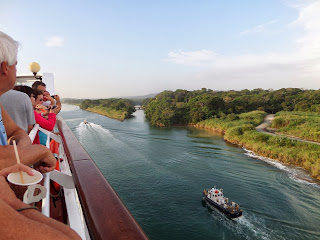Our transit of the Panama Canal lasted from about 7:00 a.m. to 4:00 p.m. to cover the 48-mile length. The canal consists of three sets of locks, plus channels and artificial lakes. We took onboard, in addition to pilots, a person who broadcast over the loudspeaker system during the transit, explaining where we were and what we were going through. It was a fascinating experience.
The canal opened on August 14, 1914 and began round-the-clock operations on May 12, 1963, with the addition of new lighting in the Culebra Cut and the three locks. Previously, transit had been limited to daylight hours. Panama took over full operation of the canal from the US at noon on December 31, 1999.
It's a bit hard to see in this picture (click on it to enlarge), but this is the approach to the first set of locks -- the Gatun Locks.
Approaching the Gatun Locks, you can see a cut that the French made in their unsuccessful attempt to create a canal. This attempt began in 1880.
This is the first of the Gatun Locks. At the left, you can see one of the engines on rails that help move the ships through the locks.
A closer view of the track and engine.
A closer view of the lock gates. The Gatun Locks are a series of three locks that lift vessels to the level of Gatun Lake.
We were followed by another cruise ship through these locks. I imagine we looked pretty similar.
The lock buildings at Gatun Locks.
Going through Gatun Lake, a man-made lake created by damming the Gatun River.
Passing through the Calebra Cut, which crosses the continental divide. The cut has already been widened in the canal expansion program, which began in September 2007. We saw quite a bit of work going on as we passed through the canal.
The lock house at Pedro Miguel Lock, which is a single lock and begins the descent to the Pacific side.
This is one of the gates at the two-stage Miraflores Locks, the last set of locks, which lower us to the Pacific level.
This is the visitor center at Miraflores Locks. Lots of tourists had a good view of our transit.
This is the lock house for Miraflores Locks.
As we exited the canal on the Pacific side, we passed the Biodiversity Museum: Panama Bridge of Life, designed by Frank Gehry.
A glimpse of Panama City.
As I mentioned, the canal is being expanded. As we entered on the Atlantic side, we could see large lock gates awaiting installation.
As we left the Miraflores Locks on the Pacific side, we could see the construction of a parallel set of new, larger locks.
The information officer from the Panama Canal mentioned that they have webcams. Here's a link if you want to see ships going through the canal. It is actually a very slow process. PanamaCanal Webcams So I looked for a time-lapse movie on Youtube -- this is a pretty good one done by someone who'd taken a NCL cruise. It's pretty much like what we experienced. FYI -- the area on the bow with the tiny swimming pool is a crew area, so that's off-duty crew enjoying the view of the transit. Transit in Time-Lapse
The transit of the Panama Canal was truly a highlight of this cruise. The canal itself is an engineering feat. The water is gravity-fed -- no pumps!
Tomorrow: Costa Rica
Subscribe to:
Post Comments (Atom)


















No comments:
Post a Comment